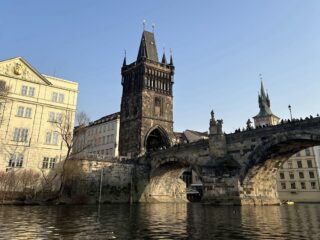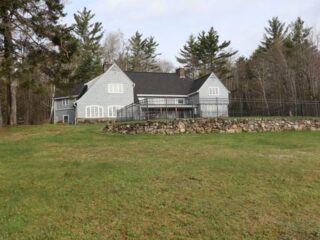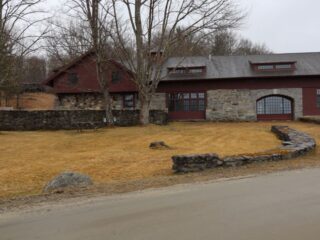By Ann Wallace
I feel no twinge of conscience
To deny me any theme
When care has cast her anchor
In the harbor of a dream.
~ 1902 J.W. Riley from “An Old Sweetheart of Mine”
Vermont was the ideal sanctuary for a writer, at the turn of the previous century, to ply the solitary craft. Southern Vermont, today, as a ski resort with historic attractions, can still boast a more laid back atmosphere.
Back in 1892 Joseph Rudyard Kipling and his bride Caroline Starr nee Balestier, visited Brattleboro, where her family lived, seeking a brief retreat from New York City, of which Kipling had taken an instant dislike. He had acquired fame two years previous, accelerated by an article that appeared in The (London) Times in March of 1890.
He found this part of New England inspiring and resolved to build a permanent residence there for himself and his wife. Their original intention was to take a trip around the world, so before they left to continue on their quest, he bought eleven acres of sloping pastureland from Carrie”s brother, Beatty, and set out westward.
Their excursion was cut short in Yokohama. Rudyard”s bank suddenly went belly up after he refused to take any more money out of his account than was necessary. Thomas Cook”s tickets for the trip were secure and so arrangements were quickly made for a full refund. They used the money to return to the States which landed them back, happily, in Brattleboro at Bliss Cottage with Carrie”s family close by. It was at Bliss that Kipling wrote the outline for the Jungle Books.
After their daughter Josephine was born on the 29th of December in 1892 just prior to the Kiplings” birthdays (Rudyard”s 30th, Caroline”s 31st), plans to build a more spacious dwelling on the Dummerston grounds they had purchased were started.
This rocky hillside faced a huge valley, eastward, with a slight view of Mt. Monadnock. New Hampshire was across the Connecticut River, Monadnock being part of the Wantastiquet mountain range, thirty miles away. Monadnock became a muse for Rudyard, a particularly moving landscape for one who had long admired a poem written by R. W. Emerson with the mountain as his subject:
Happy, I said, whose home is here!
Fair fortunes to the mountaineer!
Boon Nature to his poorest shed
Has royal pleasure-grounds outspread.
~ From Monadnoc
Carrie made arrangements with Henry Rutgers Marshall, a New York architect, who was best known for designing the library at Rutgers University, Bryn Mawr in Baltimore and several buildings at Brierly in New York. Final plans were drawn up when Marshall paid a formal visit to the area.
Naulakha was to be built high on the crest of the meadow on a fieldstone foundation, so that Monadnock could be well seen. Kipling desired windows facing east, toward this magnificent view and an economy in design. His requests were simple but made perfect sense, particularly for a writer.
Built-in bookcases were asked for, as were real doors that shut and cupboards where you want them. Much as this was a reaction to the close environment suffered at Bliss Cottage, it was also Rudyard”s love of quiet and simplicity he required to work. His direct physical involvement in the construction, during certain phases, assured his dream-house would be realized to his specifications.
Jean Pigeon, a Canadian construction engineer, along with nine other workers set to work building the house. Inexplicably, Carrie”s neer-do-well brother, Beatty, was hired as supervisor. This was the largest mistake in judgement the Kiplings made while residing in Vermont, but the impact was felt much later.
Beatty was the black sheep of the family. He had all the attributes that English presumption clung to, through centuries, about Americans. He had an aggressive personality with few New England conventions holding him in check. An alcoholic with the dangerous bent of Evel Knievel, he possessed no business acumen. Exacerbating these traits was an unprecedented popularity among the locals. He rode a wave of generosity, bear-like helpfulness and hilarity. His own sister, Carrie, couldn”t stand him but she wanted to help him become a responsible family man.
Beatty wanted to simply share his property with Carrie and Kip (as he called him) when it was originally mentioned. When Carrie offered to buy the property outright, Beatty had the rare good sense to decline. Eventually, they compromised and a proper bill of sale for the 11 acres of subdivision was drawn up with a contract. Beatty asked for haying rights verbally, but nothing was written into the contract. Later, this indiscretion was to become overblown into an argument of dewanee (Jungle Book madness) proportions.
During construction Rudyard, Beatty and the rest of the crew got along famously and in his autobiographical recollection, Something of Myself, wrote fondly of the experience, work and camaraderie.
Naulakha was delivered in modern shingle-style, which stripped away Victorian ostentatiousness to create a sedate restfulness to the eye. The style, which was of the Arts and Crafts school, was relatively new to New England.
Naulakha”s dimensions are unique for any Western world abode. Being 70 feet by 22 feet, with a ground floor and one story and a hallway running north and south on the west side, all rooms with east facing windows, it gave Kipling the impression of a boat. It has fan-like eaves, very much in usage for an Indian bungalow, and strategically-placed south end verandas. One adjoins Kipling”s study on the ground floor, the other up above served as a play area for little Josephine.
The single entrance to the house is on the sequestered west side, an impressively discreet way to enter and leave without being seen from the open approaching direction, lea-side.
Through the years in Vermont many famous authors and dignitaries, stateside and from Britain, contacted and made friendships with Rudyard. He was as excellent a conversationalist, as he was a writer. However, the closest friendship he made while he lived in the States was with Dr. Conland. Their acquaintance was made upon the birth of Josephine at Bliss Cottage. Later he became their family doctor when he had to treat Carrie for injuries suffered in a freak accident with a patent (ed) safety heating-stove. He also delivered Elsie, the Kiplings” second daughter and the only child born at Naulakha.
During his few years at Naulakha, Rudyard wrote the best-loved and prosperous stories and novels of his lifetime. Both Jungle Books were written there, as were Captain”s Courageous (inspired by Dr. Conland”s experiences), Just So Stories (which he originally made up for Josephine) and Kim, which was conceptualized there.
If any single incident could be blamed for the Kiplings” departure from idyllic Vermont, one would have to point to the date of May 6th 1896. This event was exploited terribly by the press and became personally embarrassing for all parties concerned. Tension between Beatty and Carrie was high because they were fighting over the use of land where she wished to plant sizable shrubs. Beatty was still claiming haying rights. In addition, he was perturbed that Matthew Howard had muscled in on jobs he had formerly been paid to do. A meddler by the name of Col. Francis Goodhue II wagged his tongue around the local pub about Kipling”s financial arrangement with Beatty, and steam began to build.
On the fateful day of confrontation, Rudyard had set out on a bicycle with a manuscript and letter to mail. He was riding on a bumpy country road, not too far from his house, when Beatty purposely bore down on him with his team of horses and carriage, missing him only when Rudyard”s bike fell to the right side of the road.
Boiling with anger, Beatty blasted him with threats and obscenities, while Rudyard threatened him, in return, with legal action. This only made Beatty angrier and he roared around and past him, after throwing words that hearkened back to Rudyard”s tender years. As a young boy, he had been in the abusive care of a headmistress in an English boarding school. Words like thief, coward and liar stung Rudyard to his core, in all likelihood, no matter how untrue they were.
With their peace shattered and a three-ring circus trial underway, Carrie and Rudyard made the decision to leave Naulakha. The final day was August 29, 1896. Molly Cabot, their good friend, found him pacing on Josephine”s terrace, sadly, and confided, “there are only two places in the world where I want to live: Bombay and Brattleboro, and I can”t live at either.”
James Conland saw them off at the station, but left suddenly before their boarding, because he couldn”t bear to say goodbye.
Matthew Howard was kept on as caretaker, and was instructed to keep everything maintained for their possible return. An attempt in 1899 ended in tragic disaster. After a rough sea crossing, both Rudyard and little Josephine became ill from pneumonia. Rudyard was told upon his recovery that Josephine had died. He never again laid eyes on Naulakha.
His literary achievements in Vermont gave Rudyard a preeminent position in England, which welcomed him with open arms. Wealth, fame and the Nobel Prize awarded to him in 1907 were reassurances, but his last piece of writing, a correspondence that was a dictated letter, was the most telling. Addressed to William H. Evans of Philadelphia, it was a fond reminiscence of the snowbound winters he had experienced in Vermont.
From the period of 1942 to 1992, Naulakha was abandoned, after passing through different hands, mostly friends of the Kiplings. In 1993, the Landmark Trust USA bought it and repairs and restorations, along with original furnishings, were completed exactly 100 years after the Kiplings took possession. This is a unique historical preservation society started in 1965 by the Landmark Trust of Great Britain. Both organizations share the same approach to building repair and property conservation but are fully independent.
Naulakha joins these properties in being fully accessible as rental property for vacations. A semi-annual program exists offering Stories by Rudyard Kipling which allow hundreds of school children, every year, to hear the Just So Stories where they were first told to his daughter Josephine.
*
More Articles on Rudyard Kipling
Rudyard Kipling”s Waltzing Ghost: The Literary Heritage of Brown”s Hotel
Purchase Ereaders
Buy Rudyard Kipling Ebooks
Travel to Vermont
Get the best Digital Cameras and Travel Cameras
Take a Rudyard Kipling Tour
Visit Historic Hotels in Vermont
Discuss Rudyard Kipling on LiteraryTraveler.net








